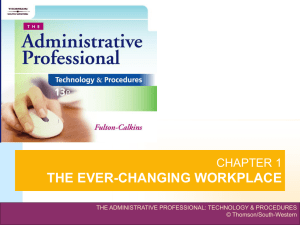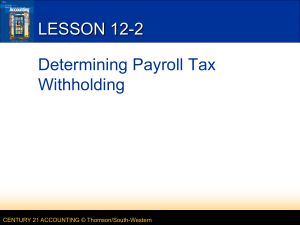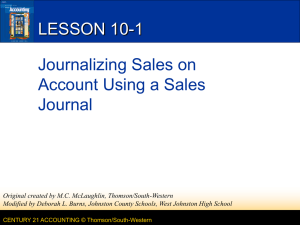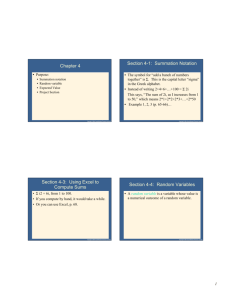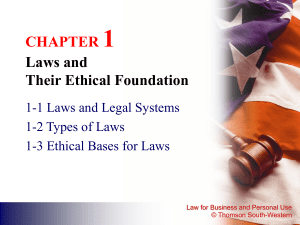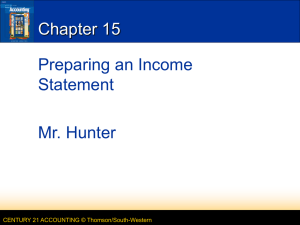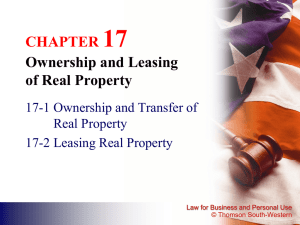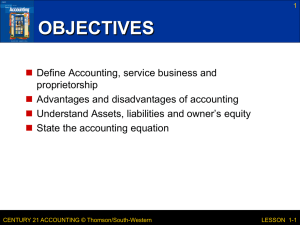Introduction to Business
advertisement
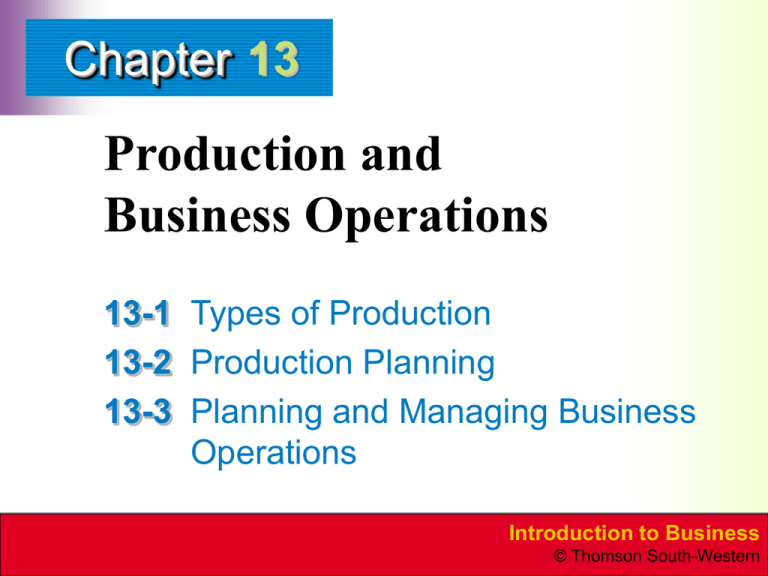
Chapter 13 Production and Business Operations 13-1 Types of Production 13-2 Production Planning 13-3 Planning and Managing Business Operations Introduction to Business © Thomson South-Western PRODUCTION AS AN ECONOMIC ACTIVITY The economy begins with production. The three categories of products used by business and consumers are: Natural Resources – raw materials supplied by nature Agricultural Products – crops and animals grown by farmers Processed Goods – products that have been changed in form to increase their value and usefulness Chapter 13 Slide 2 Introduction to Business © Thomson South-Western The following types of businesses make products: •Producers – develop products to sell to other businesses or consumers •Extractors – obtain natural resources, such as water, oil, coal, and timber from the earth for processing and use •Farmers – tend land and other natural resources to grow crops and livestock that are later sold and processed •Manufacturers – obtain materials from other producers and convert them into products for sale to consumers and other businesses. Chapter 13 Slide 3 Introduction to Business © Thomson South-Western Forms of Production The forms of production are extraction, cultivation, processing, and manufacturing. Extraction and cultivation – products are obtained from nature or grown using natural resources – most basic form of production – Ex: crops, livestock, fish Processing – involves changing and improving the form of another product. Most processed in some way – ex: timber cut to lumber/oil converted to gasoline Manufacturing – combines raw materials and processed goods into finished products. Manufacturing can be as simple as a craftsman using tools and materials to build cabinets. Chapter 13 Slide 4 Introduction to Business © Thomson South-Western MANUFACTURING Manufacturers get products or raw materials from other businesses. They change them into a form that their customers can use. They do not improve current products on the market. A manufacturing process – several manufacturers are a part of the total activity needed to produce goods that are purchased by consumers or other businesses. Types of manufacturing procedures Mass production Custom manufacturing Materials processing Chapter 13 Slide 5 Introduction to Business © Thomson South-Western Types of Manufacturing Procedures Mass Production – An assembly process that makes large number of identical products using a continuous, efficient procedure. Mass production usually requires a larger work area. Ex – Automobile plants/Beverage bottling Custom Manufacturing – building a specific and unique product to meet the needs of one customer. The manufacturer works closely with the customer to plan and design the product. Chapter 13 Slide 6 Introduction to Business © Thomson South-Western Materials Processing – changing the form of raw materials so they can be consumed or used to make other products. Ex – refineries/oil to gas Continuous Processing – raw materials move through specially designed equipment. Ex – raw milk to powdered milk Intermittent Processing – uses short production runs to produce a precise amount of a variation of product. The machines are reconfigured each time of production. Ex – A printer uses intermediate processing to complete a special order of stationary. Chapter 13 Slide 7 Introduction to Business © Thomson South-Western PRODUCTION ACTIVITIES A business cannot rely on selling the same products year after year. As customer needs and competition changes, new products will have to be developed. Product development Product research - $$$ for new ideas! Business spent over $200 billion in research in 2003. Applied research - studies existing products to develop design improvements or new product uses. Pure research – research done without a specific product in mind with a goal of discovering new solutions to problems. Product design – engineers create models and test them. The decision is made to market product. Chapter 13 Slide 8 Introduction to Business © Thomson South-Western Production planning Production process – The activities, equipment, and resources needed to manufacture a product. Production resources Personnel Inventory management Inventory – is a detailed account of a company’s materials, supplies, and finished products. Chapter 13 Slide 9 Introduction to Business © Thomson South-Western MANUFACTURING PROCEDURES Organizing the work area Improving manufacturing Chapter 13 Slide 10 Introduction to Business © Thomson South-Western CONTINUOUS PROCESS IMPROVEMENT Step 1 Involve everyone. Step 2 Identify process activities. Step 3 Establish quality performance standards. Step 4 Select measurement tools. Step 5 Monitor performance continuously. Step 6 Improve process quality. Chapter 13 Slide 11 Introduction to Business © Thomson South-Western Why have manufacturers implemented Continuous Process Improvement (CPI)? CPI is designed to help an organization achieve its goals by improving the quality of work. CPI involves everyone. It begins by listing all activities involved in the process. Standards are developed for quality. Standards are based on benchmarks or the best practices among all competitors. Measurement tools are chosen and measurements are taken to determine if activities are meeting the standards that have been set. Chapter 13 Slide 12 Introduction to Business © Thomson South-Western THE IMPORTANCE OF BUSINESS OPERATIONS The day-to-day operations of a business often determine its success or failure. Meet customer needs, have competitive prices Things can go wrong: Work efficiency Security issues Damage of buildings/equipment Lack of maintenance Poor work environment Chapter 13 Slide 13 Introduction to Business © Thomson South-Western Types of business operations Facilities management – buildings are one of the largest investments of a business. Facilities management protects the company’s investment of thousands or millions of dollars. Facilities management begins with making economic decisions about the buildings needed. Building maintenance and repair is another vital task of facilities management. Energy & environmental management. Chapter 13 Slide 14 Introduction to Business © Thomson South-Western Logistics – is managing the acquisition, movement, and storage of supplies, materials, and finished products in a business. Newer name: Supply Chain Management Major activities: locating sources of supplies Purchasing Transportation & Sales Just-In-Time – goods arrive when needed (just in time) for production, use, or sale rather than sitting in storage. Just-in-Time logistics requires careful planning and coordination. Chapter 13 Slide 15 Introduction to Business © Thomson South-Western Scheduling – involves determining the activities that need to be completed, the people who will complete the work, and the resources needed for the task. Safety and security – companies are responsible for protecting people and property. Many events and circumstances can result in injury to people or damage to property. Chapter 13 Slide 16 Introduction to Business © Thomson South-Western Information management – uses technology to access and exchange information to complete the work of an organization. Information Management has 4 goals: 1. To collect, organize, and securely maintain all needed information. 2. To provide instantaneous access to information required to perform work and make decisions. 3. To prevent access to information by those unauthorized to use it. 4. To use technology to improve communication and information sharing. Chapter 13 Slide 17 Introduction to Business © Thomson South-Western TOOLS FOR BUSINESS OPERATIONS Management tools Operational Plan – identifies how work will be done, who will do it, and what resources will be needed. A standard is a specific measurement against which an activity or result is judged. Businesses set standards for key activities to make sure an appropriate level of quality is maintained. Using technology to manage operations Chapter 13 Slide 18 Introduction to Business © Thomson South-Western Common types of operations software Project management Budgeting Scheduling Inventory Computer security Document management Manufacturing automation – monitors and often controls manufacturing machines, checks for errors and defects, and reports on production levels. Chapter 13 Slide 19 Introduction to Business © Thomson South-Western




